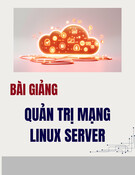
QUẢN TRỊ MẠNG
Chương 2
MÔI TRƯỜNG
WINDOWS SERVER 2008

2
Nội dung chương 2
1. Giới thiệu Windows Server 2008
2. Quản lý user và group
3. Chính sách nhóm –Group policy
4. Giới thiệu về an toàn trên Windows
2008 Server

3
1. Giới thiệu Windows 2008 Server
a. Các hệ điều hành Windows
b. Các phiên bản Windows Server 2008
c. Các khái niệm cơ bản trên Windows
Servers
d. Cài đặt Windows Server 2008

4
a. Các hệ điều hành Windows
Các hệ điều hành Windows 9x

5
Các hệ điều hành Windows (tt)
Các hệ điều hành Windows NT

![Câu hỏi ôn tập An toàn mạng môn học: Tổng hợp [mới nhất]](https://cdn.tailieu.vn/images/document/thumbnail/2025/20250919/kimphuong1001/135x160/30511758269273.jpg)


















![Đề thi cuối kì Nhập môn Mạng máy tính: Tổng hợp [Năm]](https://cdn.tailieu.vn/images/document/thumbnail/2025/20251110/nminhthoi53@gmail.com/135x160/38281762757217.jpg)



![Đề thi học kì 2 môn Nhập môn Mạng máy tính [kèm đáp án]](https://cdn.tailieu.vn/images/document/thumbnail/2025/20251014/lakim0906/135x160/23811760416180.jpg)

